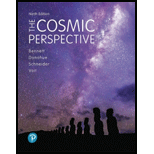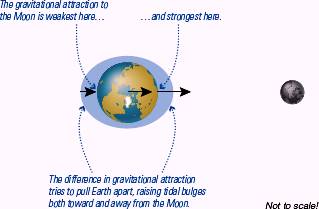
The given figure shows how the Moon causes tides on Earth. Note that the North Pole is in the center of the diagram, so the numbers 1 through 4 label points along Earth’s equator.
What do the three black arrows represent?
A. The tidal force Earth exerts on the Moon.
B. The Moon’s gravitational force at different points on Earth.
C. The direction in which Earth’s water is flowing
D. Earth’s orbital motion
Answer to Problem 1VSC
Solution:
The attraction is Minimum at point 3 which feels least gravitational attraction. Hence option (B) is correct. Since in figure gravitational pull of the Moon on Earth which gives rise to tides and the North Pole is at the center in this diagram and the numbered points are along the circumference of the equator. The black arrows represent the gravitational pull of the Moon on the Earth. The length of arrows denotes the strength of attraction. The arrow is longest at point 1, which is closest to the moon denoting that the attraction is Maximum there.
Explanation of Solution
Introduction:
Visual information used in astronomy shows how the Moon causes tides on Earth. Here in diagram North Pole is in the center of the diagram, so the numbers 1 through 4 label points along Earth’s equator.

In the figure, Tides are created by the difference in the force of attraction between the Moon and different parts of Earth. The two daily high tides occur as a location on Earth rotates through the two tidal bulges. (The diagram greatly exaggerates the tidal bulges, which raise the oceans only about 2 meters and the land only about a centimeter.)
The figure shown above shows the gravitational pull of the Moon on Earth which is responsible for giving rise to tides. At the center in this diagram the North Pole is found and along the circumference of the equator, the numbered points are there. The gravitational pull of the Moon on the Earth is represented by the black arrows. The strength of attraction is denoted by the length of arrows. The arrow is longest at point 1 and that is closest to the moon clearly denoting that the attraction is shown Maximum there. The attraction is Minimum at point 3 and thus feels least gravitational attraction. Hence option (B) is correct. The force exerted by the Moon on Earth denoted by the black arrows. Tidal force can be defined as the “stretching force which acts on a body due to the difference in gravitational attraction on its two opposite ends. Therefore, option (a) is clearly not correct.
The arrows are not denoting the direction flow of water. Hence, option (C) mentioned is also not correct. The black arrows are pointing in the direction of the moon. The orbital motion of Earth is also clearly not towards the Moon. Hence, option (D) is not correct.
Conclusion:
The gravitational pull of the Moon on Earth which gives rise to tides. The black arrows representing the gravitational pull of the Moon on the Earth and length of arrows denotes the strength of attraction. Tidal force is defined as the stretching force that acts on a body due to the difference in gravitational attraction on its two opposite ends.
Want to see more full solutions like this?
Chapter 4 Solutions
EBK THE COSMIC PERSPECTIVE
- Please help, everytime I try to input the data only one point shows on the graph. Graph of centripetal force, Fc, versus V E2 from Activity 1. Include a line of best fit and record the equation of the line.arrow_forwardBased on your graph, explain how centripetal force is affected when the hanging mass changes. Does your graph verify the relationship in the equation r = x^i + y^j = r cos ωt I + r sin ωt^j?arrow_forwardDid your experiment results in Data Table 3 verify, to within a reasonable experimental error, the condition of equilibrium of Equation 6: Στanti-clockwise = Στclockwise? Support your response with experimental data. My data shows that they are not equal to each other. So what does this mean? Thanks!arrow_forward
- Please help, everytime I try to input the data only one point shows on the graph. Graph of centripetal force, Fc, versus V E2 from Activity 1. Include a line of best fit and record the equation of the line.arrow_forwardExplain how your experiment met the condition for equilibrium in Equation 4: ΣFvertical = ΣFy = 0.arrow_forwardCan i get answer and solution for this question and can you teach me What we use to get the answer.arrow_forward
- Can i get answer and solution and can you teach me how to get it.arrow_forwardConsider a image that is located 30 cm in front of a lens. It forms an upright image 7.5 cm from the lens. Theillumination is so bright that that a faint inverted image, due to reflection off the front of the lens, is observedat 6.0 cm on the incident side of the lens. The lens is then turned around. Then it is observed that the faint,inverted image is now 10 cm on the incident side of the lens.What is the index of refraction of the lens?arrow_forward2. In class, we discussed several different flow scenarios for which we can make enough assumptions to simplify the Navier-Stokes equations enough to solve them and obtain an exact solution. Consulting the cylindrical form of the Navier-Stokes equations copied below, please answer the following questions. др a 1 a + +0x- + +O₂ = Pgr + μl 18²v, 2 ave ²v₁] az2 + at or r de r Əz dr ar Vodvz др [18 + + +Or + +Vz = Pgz +fl at ar r 20 ôz ôz dr ave дов V,Ve ave +Or + + = pge at dr r 80 Əz + az2 a.) In class, we discussed how the Navier-Stokes equations are an embodiment of Newton's 2nd law, F = ma (where bolded terms are vectors). Name the 3 forces that we are considering in our analysis of fluid flow for this class. др a 10 1 ve 2 av 2200] + +μ or 42 30 b.) If we make the assumption that flow is "fully developed" in the z direction, which term(s) would go to zero? Write the term below, describe what the term means in simple language (i.e. do not simply state "it is the derivative of a with…arrow_forward
- 1. Consult the form of the x-direction Navier-Stokes equation below that we discussed in class. (For this problem, only the x direction equation is shown for simplicity). Note that the equation provided is for a Cartesian coordinate system. In the spaces below, indicate which of the following assumptions would allow you to eliminate a term from the equation. If one of the assumptions provided would not allow you to eliminate a particular term, write "none" in the space provided. du ди at ( + + + 매일) du ди = - Pgx dy др dx ²u Fu u + fl + ax2 ay² az2 - дх - Əz 1 2 3 4 5 6 7 8 9 Assumption Flow is in the horizontal direction (e.g. patient lying on hospital bed) Flow is unidirectional in the x-direction Steady flow We consider the flow to be between two flat, infinitely wide plates There is no pressure gradient Flow is axisymmetric Term(s) in equationarrow_forwardDon't use ai to answer I will report you answerarrow_forwardwhy did the expert subtract the force exerted by the hand and the elbow by the force due to the weight of the hand and forearm and force exerted by the tricep. Does the order matter and how do you determine what to put first. Question 4 AP, CHAPTER 13 FROM BASIC BIOMECHANICS 8TH EDITIONarrow_forward
 College PhysicsPhysicsISBN:9781305952300Author:Raymond A. Serway, Chris VuillePublisher:Cengage Learning
College PhysicsPhysicsISBN:9781305952300Author:Raymond A. Serway, Chris VuillePublisher:Cengage Learning University Physics (14th Edition)PhysicsISBN:9780133969290Author:Hugh D. Young, Roger A. FreedmanPublisher:PEARSON
University Physics (14th Edition)PhysicsISBN:9780133969290Author:Hugh D. Young, Roger A. FreedmanPublisher:PEARSON Introduction To Quantum MechanicsPhysicsISBN:9781107189638Author:Griffiths, David J., Schroeter, Darrell F.Publisher:Cambridge University Press
Introduction To Quantum MechanicsPhysicsISBN:9781107189638Author:Griffiths, David J., Schroeter, Darrell F.Publisher:Cambridge University Press Physics for Scientists and EngineersPhysicsISBN:9781337553278Author:Raymond A. Serway, John W. JewettPublisher:Cengage Learning
Physics for Scientists and EngineersPhysicsISBN:9781337553278Author:Raymond A. Serway, John W. JewettPublisher:Cengage Learning Lecture- Tutorials for Introductory AstronomyPhysicsISBN:9780321820464Author:Edward E. Prather, Tim P. Slater, Jeff P. Adams, Gina BrissendenPublisher:Addison-Wesley
Lecture- Tutorials for Introductory AstronomyPhysicsISBN:9780321820464Author:Edward E. Prather, Tim P. Slater, Jeff P. Adams, Gina BrissendenPublisher:Addison-Wesley College Physics: A Strategic Approach (4th Editio...PhysicsISBN:9780134609034Author:Randall D. Knight (Professor Emeritus), Brian Jones, Stuart FieldPublisher:PEARSON
College Physics: A Strategic Approach (4th Editio...PhysicsISBN:9780134609034Author:Randall D. Knight (Professor Emeritus), Brian Jones, Stuart FieldPublisher:PEARSON





